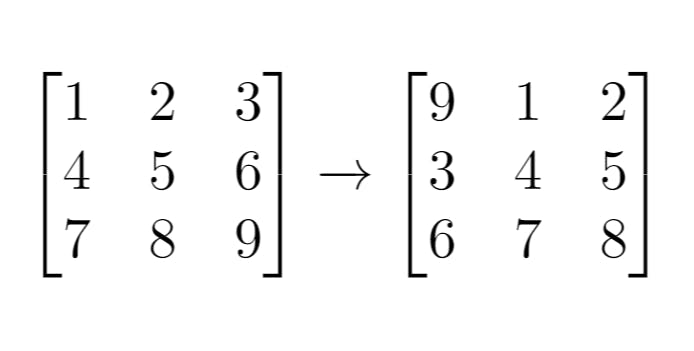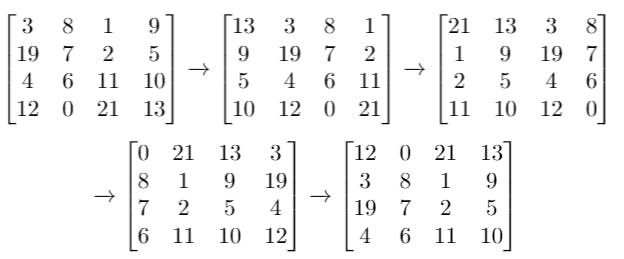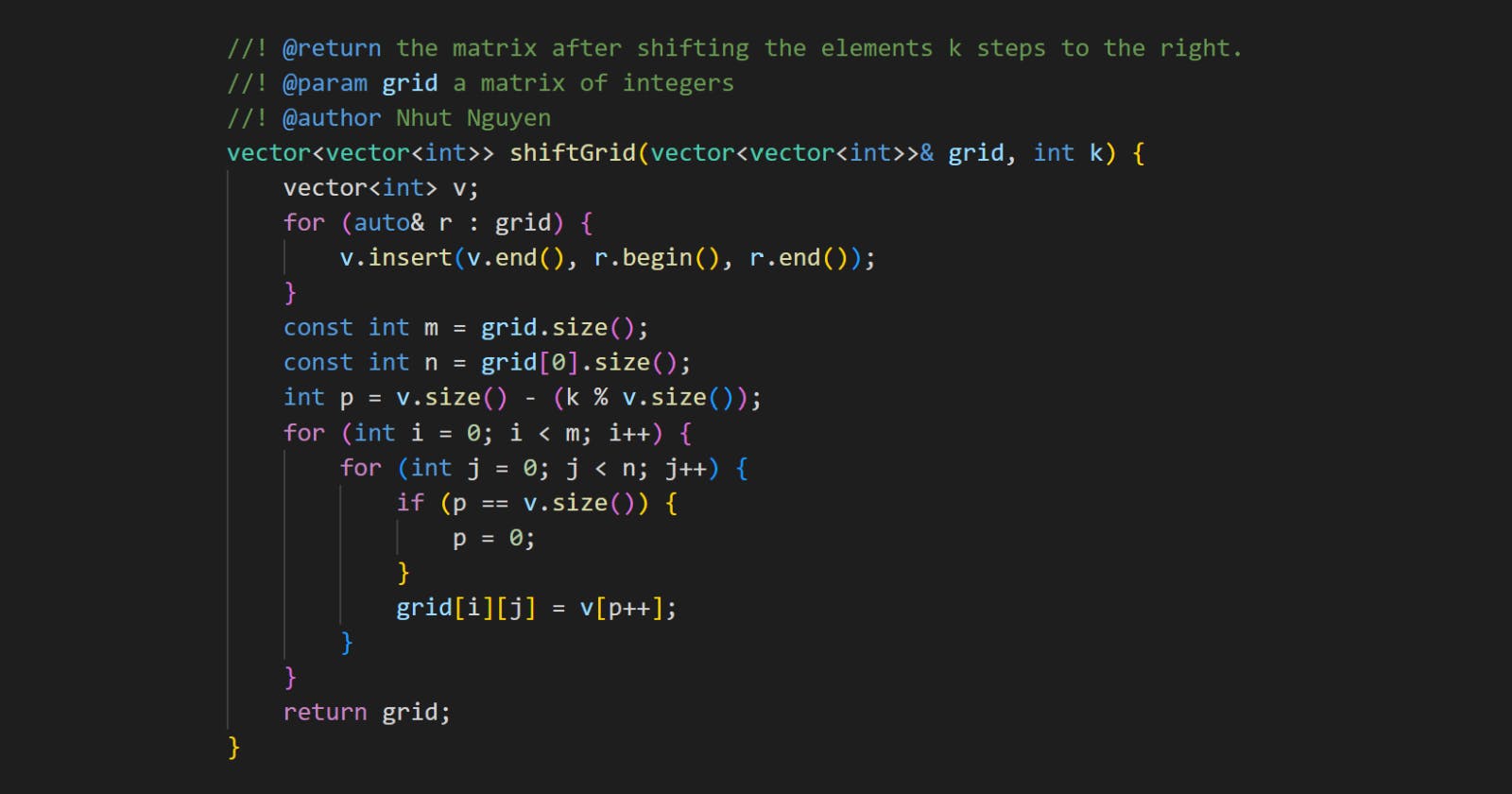Problem statement
Given a 2D grid of size m x n and an integer k. You need to shift the grid k times.
In one shift operation:
Element at
grid[i][j]moves togrid[i][j + 1].Element at
grid[i][n - 1]moves togrid[i + 1][0].Element at
grid[m - 1][n - 1]moves togrid[0][0].
Return the 2D grid after applying shift operation k times.
Example 1

Input: grid = [[1,2,3],[4,5,6],[7,8,9]], k = 1
Output: [[9,1,2],[3,4,5],[6,7,8]]
Example 2

Input: grid = [[3,8,1,9],[19,7,2,5],[4,6,11,10],[12,0,21,13]], k = 4
Output: [[12,0,21,13],[3,8,1,9],[19,7,2,5],[4,6,11,10]]
Example 3
Input: grid = [[1,2,3],[4,5,6],[7,8,9]], k = 9
Output: [[1,2,3],[4,5,6],[7,8,9]]
Constraints
m == grid.length.n == grid[i].length.1 <= m <= 50.1 <= n <= 50.-1000 <= grid[i][j] <= 1000.0 <= k <= 100.
Solution: Convert a 2D array into an 1D one
You can convert the 2D grid into a 1D vector v to perform the shifting easier. One way of doing this is concatenating the rows of the matrix.
If you shift the grid
k = i*Ntimes whereN = v.size()andiis any non-negative integer, you go back to the original grid; i.e. you did not shift it.If you shift the grid
ktimes with0 < k < N, the first element of the result starts fromv[N - k].In general, the first element of the result starts from
v[N - k%N].
Example 1
For grid = [[1,2,3],[4,5,6],[7,8,9]]:
It can be converted into a 1D vector
v = [1,2,3,4,5,6,7,8,9]of sizem*n = 9.With
k = 1the shiftedgridnow starts fromv[9 - 1] = 9.The final result is
grid = [[9,1,2][3,4,5][6,7,8]].
Code
#include <vector>
#include <iostream>
using namespace std;
vector<vector<int>> shiftGrid(vector<vector<int>>& grid, int k) {
vector<int> v;
for (auto& r : grid) {
v.insert(v.end(), r.begin(), r.end());
}
const int m = grid.size();
const int n = grid[0].size();
int p = v.size() - (k % v.size());
for (int i = 0; i < m; i++) {
for (int j = 0; j < n; j++) {
if (p == v.size()) {
p = 0;
}
grid[i][j] = v[p++];
}
}
return grid;
}
void printResult(vector<vector<int>>& grid) {
cout << "[";
for (auto& r : grid) {
cout << "[";
for (int a: r) {
cout << a << ",";
}
cout << "]";
}
cout << "]\n";
}
int main() {
vector<vector<int>> grid{{1,2,3},{4,5,6},{7,8,9}};
auto result = shiftGrid(grid, 1);
printResult(result);
grid = {{3,8,1,9},{19,7,2,5},{4,6,11,10},{12,0,21,13}};
result = shiftGrid(grid, 4);
printResult(result);
grid = {{1,2,3},{4,5,6},{7,8,9}};
result = shiftGrid(grid, 9);
printResult(result);
}
Output:
[[9,1,2,][3,4,5,][6,7,8,]]
[[12,0,21,13,][3,8,1,9,][19,7,2,5,][4,6,11,10,]]
[[1,2,3,][4,5,6,][7,8,9,]]
Complexity
Runtime:
O(mn)(the nestedforloops), wherem = grid.length,n = grid[i].length.Extra space:
O(mn)(the vectorv).
C++ notes
To convert a 2D matrix into a 1D vector, you can use the vector's function
insert().The modulo operator
%is usually used to index an array to ensure the index is inbound.
Thanks for reading. Feel free to share your thought about my content.
What is your approach? The problem was picked from leetcode.com. You can submit your solution in any programming language and check the performance.

